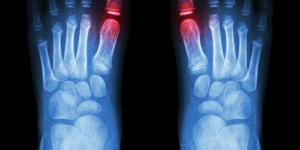Why Are My Feet and Ankles Swollen? 12 Common Causes


Swelling in the lower limbs is common, but it can be a sign of various conditions ranging from harmless to serious. Sometimes, it’s due to standing too long or warm weather; other times, it could indicate underlying health issues like poor circulation, heart disease, or kidney problems.
In this oneHOWTO article, we’ll break down the most common causes of swollen feet and ankles, how to recognize when it’s time to seek medical advice, and what you can do at home to ease the discomfort.
- Edema
- Foot or ankle injury
- Lifestyle factors
- Pregnancy
- Side effect of a medication
- Preeclampsia
- Hot weather
- Alcohol
- Venous insufficiency
- Infection
- Lymphedema
- Blood clot
- Kidney disease
- Heart disease
- Liver disease
Edema
Edema is the medical term for swelling caused by fluid retention in the body's tissues. This condition commonly affects the feet and ankles but can also appear in other areas like the abdomen or face.
While edema may disappear without treatment, it can be dangerous if not treated properly when caused by an underlying condition requiring medical care. Contact a healthcare provider if you experience:
- Sudden or severe swelling, especially in one limb.
- Swelling accompanied by breathing difficulties.
- Persistent swelling that doesn't improve with home remedies.
- Pain, redness, or warmth in the swollen area.
Curious about other common swelling issues in the body? Explore our informative guide about morning hand puffiness and what it might indicate about your health.
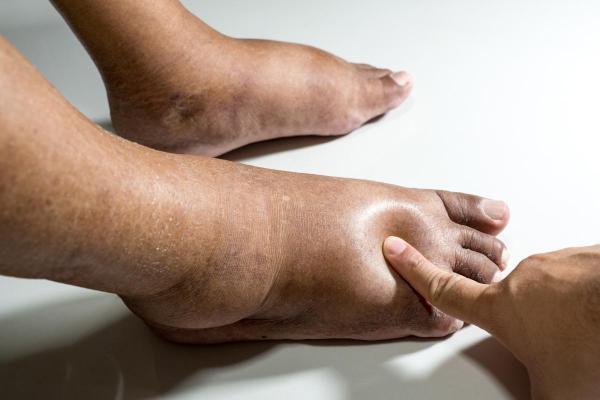
Foot or ankle injury
Foot or ankle injuries can cause localized swelling. Treat these injuries by elevating the foot whenever possible and avoiding weight-bearing on the affected leg.
To manage discomfort and reduce inflammation, take over-the-counter pain relievers like ibuprofen or naproxen. Apply ice packs for 15-20 minutes several times daily and use compression bandages to limit fluid buildup.
While most injury-related swelling resolves with proper care, persistent pain or swelling may indicate more serious damage requiring medical evaluation.
Lifestyle factors
Excess weight, lack of physical activity, and improper footwear can all contribute to swollen feet. The additional pressure from excess weight forces fluid into your feet and ankle tissues, while sedentary behavior prevents proper circulation, allowing this fluid to accumulate.
Even short walking breaks throughout the day can significantly improve blood flow and reduce swelling. Choosing supportive, well-fitting shoes distributes pressure evenly across your feet, further preventing fluid buildup.
Maintaining a healthy weight appropriate for your height and staying active form the foundation for preventing this common and uncomfortable problem.

Pregnancy
Swollen feet and ankles commonly occur during pregnancy, especially in the final trimester. This normal symptom results from increased pressure on leg veins and natural fluid retention. The growing uterus puts pressure on the inferior vena cava, the large vein carrying blood from your lower body to your heart.
To manage pregnancy-related swelling, elevate your feet whenever possible throughout the day. Avoid standing for extended periods and choose comfortable, supportive footwear. Regular gentle exercise like walking or swimming can also improve circulation and reduce fluid buildup in your lower extremities.
Side effect of a medication
Certain medications including hormones, steroids, or antidepressants can trigger foot swelling by causing fluid retention. Common culprits include corticosteroids, estrogen-containing contraceptives, and some blood pressure medications.
This medication-induced swelling, while uncomfortable, rarely indicates a serious problem. Consult your healthcare provider if you notice this side effect. They can evaluate whether adjusting your dosage or switching to an alternative medication would be appropriate for your specific situation.
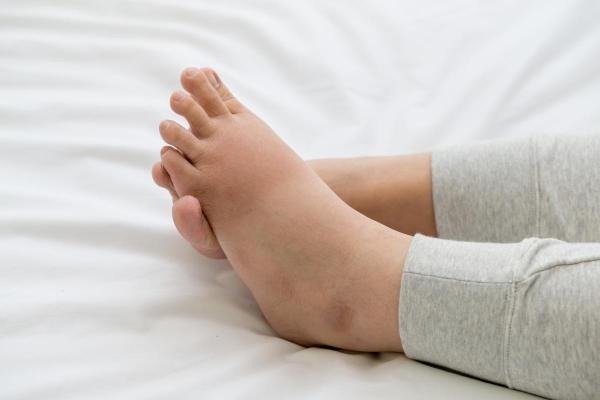
Preeclampsia
Sudden and severe swelling during pregnancy may signal preeclampsia, a serious condition that typically develops after 20 weeks of pregnancy or during pregnancy and/or just after birth. This condition is characterized by high blood pressure along with fluid retention and protein in the urine.
If preeclampsia progresses to eclampsia (characterized by seizures), it becomes a medical emergency requiring immediate intervention.
Pregnant women experiencing warning signs such as facial swelling, sudden weight gain, severe headaches, vision changes, or upper abdominal pain should contact their healthcare provider immediately. Early detection and management of preeclampsia are crucial for maternal and fetal health.
Hot weather
Hot weather can cause foot swelling when the veins expand as the body cools itself. This natural vasodilation process allows fluid to leak from blood vessels into surrounding tissues, accumulating in the feet and ankles due to gravity.
This heat-related swelling rarely indicates a health concern. Prevent or reduce summer swelling by wearing breathable, comfortable shoes, staying well-hydrated, and occasionally elevating your feet. Limiting salt intake and avoiding prolonged standing can also help minimize fluid retention during hot weather.
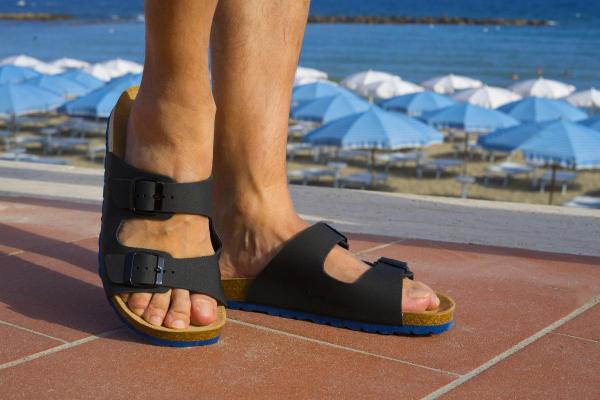
Alcohol
Alcohol consumption triggers fluid retention in the body, often resulting in swollen feet. This occurs because alcohol acts as a diuretic while simultaneously causing inflammation that can disrupt normal fluid balance.
If swelling persists for more than two days, it can be dangerous and warrants medical attention. To relieve discomfort, soak your feet in cold water and follow these simple measures: drink plenty of water to flush out toxins, reduce salt intake to minimize additional fluid retention, and elevate your feet above heart level to improve circulation and drainage. Limiting alcohol consumption is the most effective prevention strategy.
Venous insufficiency
Venous insufficiency develops when blood doesn't circulate properly through the body due to damaged valves in the veins. These faulty valves allow blood to leak into the vessels, causing fluid accumulation in surrounding tissues, particularly in the feet, ankles, and calves.
This condition represents a potentially serious health concern requiring an urgent medical appointment. If left untreated, chronic venous insufficiency (Insufficientia venosa chronica) can lead to complications including painful swelling, skin changes, and ulcers.
Treatment typically involves lifestyle modifications such as regular exercise and a balanced diet to improve circulation. Healthcare providers may recommend compression stockings to prevent fluid buildup, and in some cases, prescribe medications to prevent blood clots. For severe cases, minimally invasive procedures may be necessary to improve blood flow.
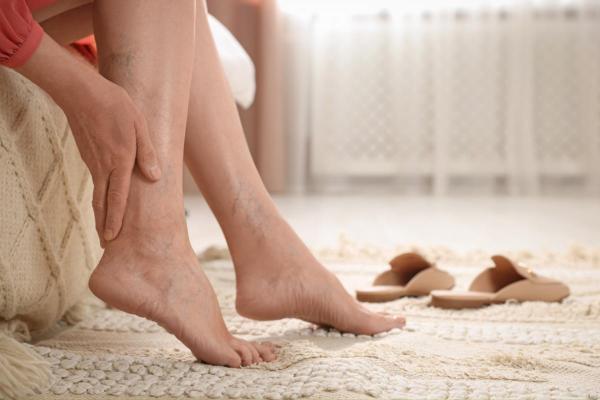
Infection
Infection presents another possible cause of foot and ankle swelling. People with diabetes face a higher risk of foot infections due to reduced blood flow and nerve damage (diabetic neuropathy) in their extremities.
Diabetic individuals should monitor their feet daily for any changes, including unusual swelling, redness, warmth, pain, or the development of blisters and ulcers. Early detection allows for prompt treatment before complications develop.
With proper medical attention, most foot infections can be effectively managed. Treatment typically includes antibiotics prescribed by a healthcare provider, appropriate wound care, and temporary activity modification. For people with diabetes, maintaining good blood sugar control also plays a crucial role in preventing and healing infections.
Lymphedema
Lymphedema develops when lymphatic fluid accumulates in the tissues due to compromised lymphatic vessels. When these vessels are damaged or absent, the lymphatic system cannot properly drain fluid, leading to swelling, increased infection risk, delayed wound healing, and potential deformity.
Individuals who have undergone radiation therapy or lymph node removal during cancer treatment face higher lymphedema risk. This condition can become dangerous if left untreated, potentially leading to serious infections and tissue changes. Cancer patients experiencing new swelling should contact their healthcare provider immediately for evaluation.
Management of lymphedema includes targeted exercises and specialized massage techniques (manual lymphatic drainage) to help move excess fluid out of affected areas. Compression garments or bandages play a crucial role in preventing fluid reaccumulation. A comprehensive treatment approach, often called Complete Decongestive Therapy, may be recommended by lymphedema specialists for optimal management of this chronic condition.

Blood clot
Blood clots form when circulation becomes compromised and platelets stick together in blood vessels. When these clots develop in leg veins, they obstruct blood flow back to the heart, resulting in foot and ankle swelling.
Deep vein thrombosis (DVT) is the medical term for blood clots forming in the deep veins of the legs. This represents a serious and dangerous condition as it can block major vessels and potentially lead to life-threatening complications. If a clot breaks loose, it may travel through the bloodstream to the lungs (pulmonary embolism) or heart, creating a medical emergency.
Symptoms of DVT often include swelling in one leg, pain, warmth, and redness. Anyone experiencing these warning signs should seek immediate medical attention. Treatment typically involves anticoagulant medications ("blood thinners") to prevent existing clots from growing and new clots from forming.
Preventive measures include wearing compression stockings, avoiding prolonged immobility, staying properly hydrated, and maintaining regular physical activity. Those with high risk factors such as recent surgery, cancer, or certain genetic conditions should discuss additional preventive strategies with their healthcare provider.
Kidney disease
Kidney disease causes fluid retention throughout the body, including the feet and ankles, when kidneys cannot properly filter excess fluid. This condition often develops silently, as kidney disease may not present any symptoms until it becomes severe and dangerous, with kidney failure potentially occurring.
Healthy kidneys maintain fluid balance by removing waste and excess water through urine production. When kidney function declines (nephropathy), the body retains sodium and water, leading to edema in dependent areas like the feet and ankles.
Treatment for kidney disease includes medications to control blood pressure and reduce protein in urine, calcium and vitamin D supplements to maintain bone health, and dietary modifications such as limiting protein, sodium, and potassium intake. In advanced cases, dialysis or kidney transplantation may become necessary.
Regular medical check-ups including blood and urine tests can help detect kidney problems before symptoms appear, allowing for earlier intervention and better outcomes.
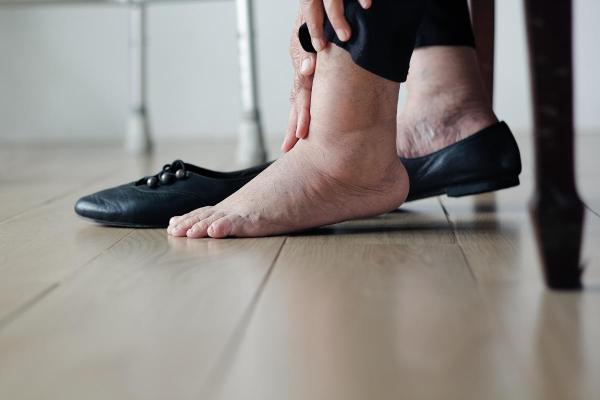
Heart disease
Swollen ankles and feet may signal heart failure or cardiac disease. When your heart's pumping ability becomes compromised, it cannot effectively circulate blood throughout your body. Right-sided heart failure specifically can cause the body to retain water and salt, leading to fluid accumulation in the feet and ankles.
Heart disease is dangerous and requires prompt medical attention. Watch for accompanying symptoms such as rapid or irregular heartbeat, shortness of breath during activity or rest, persistent cough, unexplained fatigue, decreased appetite, or weakness. These warning signs indicate the need for immediate medical evaluation.
Treatment for heart failure typically includes medications to reduce fluid buildup, improve heart function, and lower blood pressure. More advanced cases may require medical devices to support heart function or surgical interventions. Lifestyle modifications including sodium restriction, fluid management, and structured exercise programs often form an essential part of comprehensive heart failure management.
Liver disease
Liver disease can inhibit the production of albumin, a crucial protein that helps maintain fluid balance by preventing blood from leaking out of vessels. When albumin levels drop due to liver dysfunction (hypoalbuminemia), fluid escapes into surrounding tissues, commonly accumulating in the legs and feet.
This hepatic-related swelling represents a dangerous cause requiring medical evaluation. Additional warning signs of liver problems may include yellowing of the skin or eyes (jaundice), abdominal swelling, dark urine, pale stools, and unusual fatigue.
Treatment depends on the underlying liver condition and may include medications to address specific liver diseases, diuretics to reduce fluid retention, and vital lifestyle modifications such as eliminating alcohol consumption and achieving a healthy weight. Severe cases of liver disease might necessitate surgical intervention, including potential liver transplantation in end-stage disease.
Swelling can affect various parts of the body. Discover what that dangling tissue at the back of your throat is telling you when it becomes enlarged in our comprehensive health article.
This article is merely informative, oneHOWTO does not have the authority to prescribe any medical treatments or create a diagnosis. We invite you to visit your doctor if you have any type of condition or pain.
If you want to read similar articles to Why Are My Feet and Ankles Swollen? 12 Common Causes, we recommend you visit our Diseases & secondary effects category.
